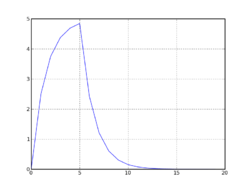Leaky integrator
In mathematics, a leaky integrator equation is a specific differential equation, used to describe a component or system that takes the integral of an input, but gradually leaks a small amount of input over time. It appears commonly in hydraulics, electronics, and neuroscience where it can represent either a single neuron or a local population of neurons.[1]

A graph of a solution to a leaky integrator; the input changes at T=5.
This is equivalent to a 1st-order lowpass filter with cutoff frequency far below the frequencies of interest.
Equation
The equation is of the form
where C is the input and A is the rate of the 'leak'.
General solution
As the equation is a nonhomogeneous first-order linear differential equation, its general solution is
where is a constant, and is an arbitrary solution of the equation.
gollark: I don't think I can type that fast.
gollark: Hmm, 23 LoC/s, impressive.
gollark: Idea: video compression?
gollark: n is all quaternionic values satisfying n³ = 7, yes.
gollark: Not really. You can run arbitrary shell commands. They exist in a container or something.
References
- Eliasmith, Anderson, Chris, Charles (2003). Neural Engineering. Cambridge, Massachusetts: MIT Press. pp. 81.
This article is issued from Wikipedia. The text is licensed under Creative Commons - Attribution - Sharealike. Additional terms may apply for the media files.